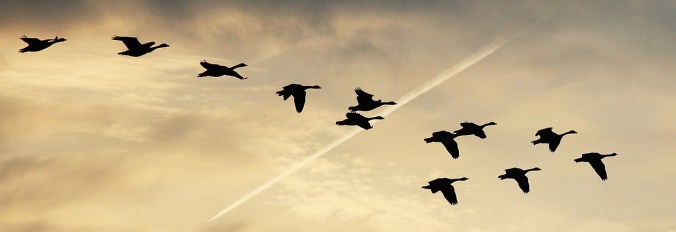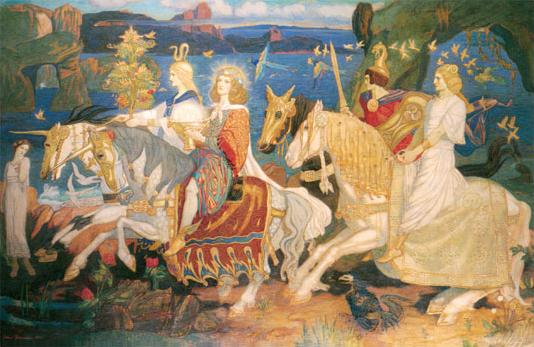The Wild Hunt is a very widespread motif in Indo-European folklore and mythology, appearing in Indian, Greek, Czech, Polish, Slovenian, Swedish, Dutch, Danish, German, Italian, Spanish, English, and Welsh legends. The deity who leads it varies from one culture to another, and it has different names in different places, but enough shared characteristics to be fairly certain that it is the same folklore motif. It even has its own classification number, ATU E501.
The hunt is often seen as a cavalcade of dead warriors or other spirits. In many legends, it is Odin or Woden who leads the hunt, and the Einherjar (his army) who ride with him; in German they are called the Totenheer, the army of the dead. In this guise, his by-name is Herian, and this may be the origin of the name Herne, who was also associated with the Wild Hunt. The goddesses Berchta and Holda are also associated with the Wild Hunt, and with geese. The whirring sound made by the wings of geese in flight was associated with the Wild Hunt, and it is sometimes called Gabriel Hounds or Ratchet Hounds. Sometimes a lame goose which has trouble keeping up follows the Hunt.

Geese in flight were often thought to be the Wild Hunt, because of the whirring of their wings.
In Southern Europe, the hunt is associated with Hecate and her hounds. In India, it is led by Rudra, the storm god, and the Maruts ride with him. In the Vedic period, Rudra’s epithet was Pashupati, Lord of the Animals (also a title given to Merlin and Cernunnos in Europe). This epithet now belongs to Shiva. (Shiva, meaning the kind one, was originally an epithet of Rudra, and they are often seen as the same deity.)
Several legendary leaders of the Wild Hunt were knights or kings who committed some crime, or who had not completed their task on Earth. In Christian folklore, those who were too good for hell but not good enough for heaven would often be consigned to ride in the Wild Hunt.
One of my favourite legends associated with the Wild Hunt is that of Wild Edric, who was an Anglo-Saxon nobleman who put up a valiant resistance, but surrendered too soon to the conquering Normans. This is why he was condemned to wander with the Wild Hunt, where his job is to warn of imminent invasion or war. Seeing the Wild Hunt is often said to be an omen of war. Wild Edric was last seen shortly before the Crimean War by a miner’s daughter. He was riding with his faery wife, Lady Godda, who was dressed in green. Wild Edric’s sword is said to be in Bomere Pool, worn by a fish that cannot be caught with any net.

Trout swimming
There was a sighting of the Wild Hunt in Sweden in the nineteenth century, where it was pursuing a white hind and a naked woman with a distended stomach. In other parts of Sweden, the hunt pursues St Walpurga for nine nights culminating on Walpurgisnacht. Walpurga wears a golden crown and carries a distaff, a wheatsheaf, and a three-cornered mirror that gives glimpses of the future. Bonfires are lit on May Eve to protect her from the hunters.
The Hunt is generally sighted at the solstices, particularly the winter solstice, and on spirit roads across the landscape. It is heralded by a clap of thunder, the noise of wind in the trees, ghostly music, the rattle of chains, the baying of hounds, the clash of swords, or whinnying of horses, or the sound of a huning horn. Just before it disappears, there is an increase in its loudness, followed by an eerie silence.
Jakob Grimm believed that the hunt was originally a cavalcade of gods riding out in solemn and stately procession (rather like the faery rade or Sluagh Sidhe). It could also be a procession of spirits riding on the host-paths of the dead, which often align with old trackways across the landscape.

Riders of the Sidhe (1911), painting by John Duncan. Public Domain.
Summer thunderstorms are often very evocative of the Wild Hunt, and can easily provoke images of horses thundering across the sky, especially when the storm seems to circle overhead.
As W B Yeats so beautifully put it,
Once every people in the world believed that trees were divine, and could take a human or grotesque shape and dance among the shadows; and that deer, and ravens and foxes, and wolves and bears, and clouds and pools, almost all things under the sun and moon, and the sun and moon, were not less divine and changeable. They saw in the rainbow the still bent bow of a god thrown down in his negligence; they heard in the thunder the sound of his beaten water-jar, or the tumult of his chariot wheels; and when a sudden flight of wild duck, or of crows, passed over their heads, they thought they were gazing at the dead hastening to their rest; while they dreamed of so great a mystery in little things that they believed the waving of a hand, or of a sacred bough, enough to trouble far-off hearts, or hood the moon with darkness.
I was prompted to write this post by a marvellous blogpost by Lorna Smithers about the association of the Wild Hunt with Gwyn ap Nudd, and a conversation about the Wild Hunt in the comments section of Brenton Dickieson’s blog (a friendly and very erudite corner of the internet).
I wrote about the Wild Hunt in my book, The Sacred Grove: Mysteries of the Forest. I would also recommend reading In Search of Herne the Hunter, by Eric Fitch.
If you enjoyed this post, you might like my books.



I first read about the Wild Hunt in Alan Garner’s The Moon of Gomrath, and have been curious about it ever since. Thanks for helping to assuage some of my curiosity.
LikeLiked by 1 person
Indeed, Garner is very well versed in folklore and mythology.
LikeLike
Pingback: 300 followers | Dowsing for Divinity